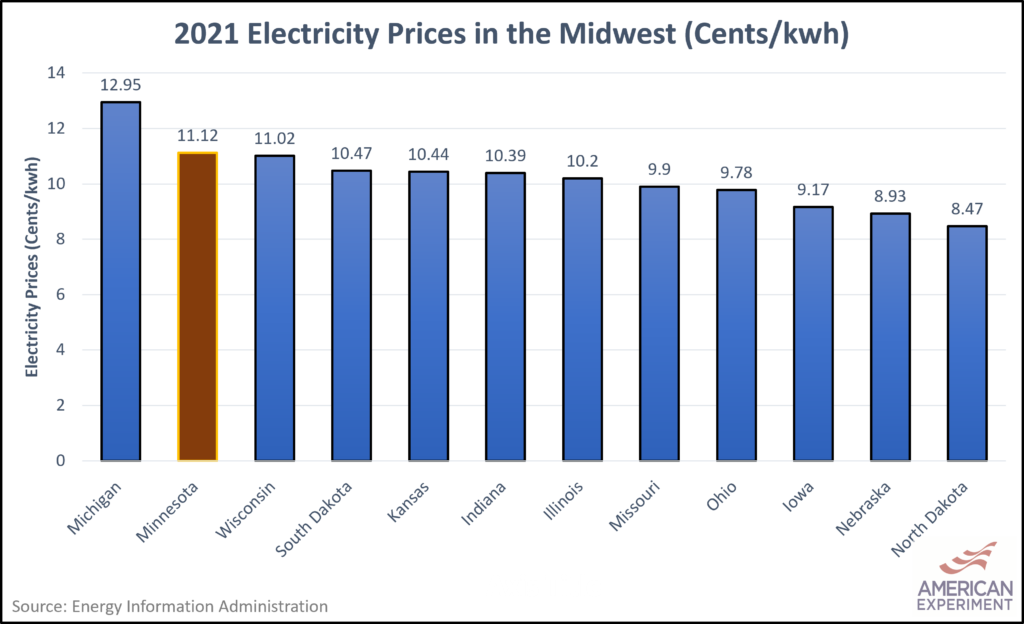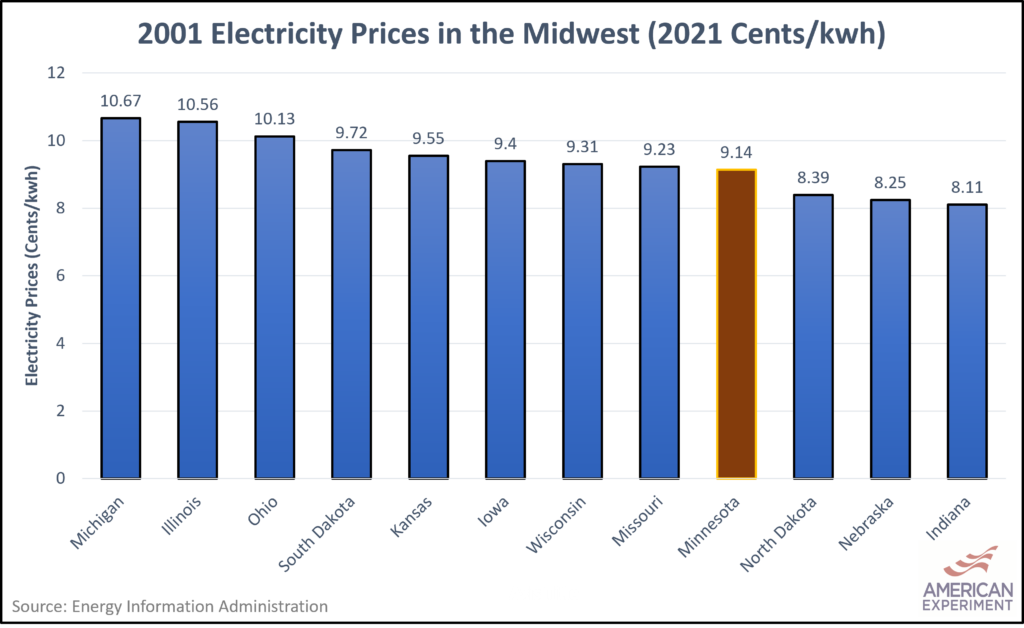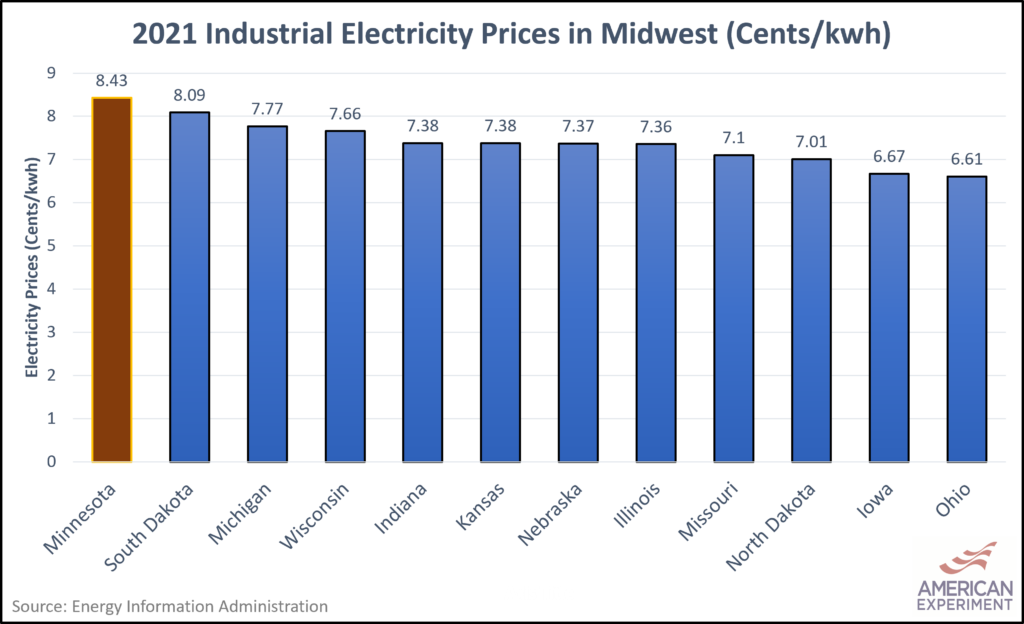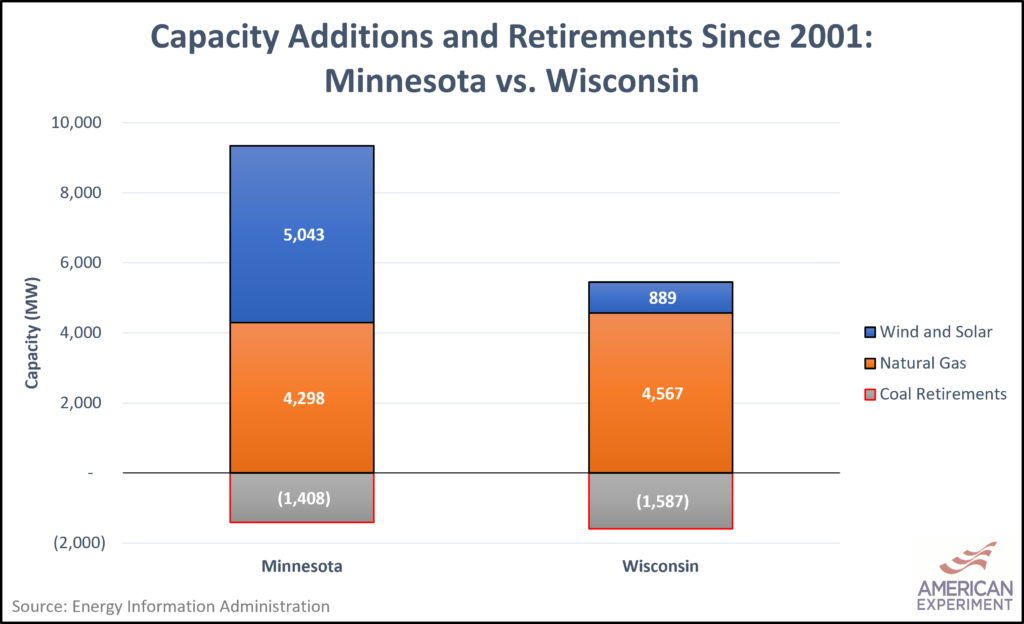Minnesota electricity prices surpass Wisconsin in 2021 for first time
The average cost of electricity in Minnesota surpassed Wisconsin in 2021, marking the first time since the Energy Information Administration (EIA) started recording data that Minnesota electricity prices have exceeded that of its neighboring state.
Minnesota electricity prices once had a price advantage over Wisconsin as high as 15 percent in 2011 — a double-digit advantage that would last until 2015. However, this was erased entirely as Minnesota electricity prices increased by 22 percent since 2011, nearly four times faster than Wisconsin prices at 6 percent.
This is bad news for Minnesota, as it now has the second most expensive electricity prices in the Midwest (Figure 1) and the fourteenth most expensive in the country.

This is much different than 2001, when Minnesota had the fourth least expensive electricity prices in the Midwest (Figure 2) and the fourteenth least expensive in the country.

High electricity prices make Minnesota less competitive for business and increase the cost of daily life for Minnesotans compared to their neighbors.
Adding to the pain, Minnesota surpassed South Dakota in 2021 for the most expensive industrial electricity prices in the Midwest (Figure 3), also becoming the twelfth most expensive in the country.

When businesses pay more for electricity, Minnesota consumers pay more for products.
Minnesota electricity prices rose dramatically over the years
It’s remarkable that Minnesota electricity prices overtook Wisconsin considering how fast Wisconsin prices have been growing over the years. In 2021, Wisconsin had the eleventh fastest-growing electricity prices in the country since 2001.
Not to be outdone, however, Minnesota had the sixth fastest-growing electricity prices during the same time.
A major factor behind Minnesota and Wisconsin electricity rates increasing faster than most of the nation has to do with poor energy policy.
Lawmakers in both states prioritized replacing coal-fired power plants before the end of their useful lives with natural gas, wind, and solar energy sources, which required billions of dollars of new investments that were charged to ratepayers.
The goal of lowering CO2 emissions effectively superseded affordability as the highest virtue of an electrical grid — no matter the cost, as shown by Minnesota and Wisconsin, with electricity prices growing faster than the national average by 62 percent and 52 percent, respectively.
Unfortunately for Minnesota consumers, Minnesota policy focused more heavily on building wind and solar energy sources than Wisconsin. This led to higher costs in Minnesota over time because wind and solar are intermittent energy sources that require backup power plants to provide electricity for when the wind isn’t blowing, and the sun isn’t shining. As such, they represent a premium on the cost of electricity due to their inability to displace capacity, especially as their share of the energy mix increases.
In other words, Minnesota ended up building more power facilities than Wisconsin to replace coal power because of an over-reliance on wind and solar, and these larger investments led to higher costs for ratepayers.
The track record speaks for itself
Since 2001, Minnesota and Wisconsin retired a net of 1,400 MW and 1,600 MW of coal capacity, respectively. (Wisconsin added coal units in 2008, 2010, and 2011 that offset some of the state’s retirements).
To replace these coal-fired power plants, both states built roughly the same amount of natural gas capacity. Wisconsin built over 4,500 MW while Minnesota built roughly 4,300 MW.
However, because both states had renewable energy mandates during this time, they also invested in wind and solar energy sources.
Minnesota law requires that utility companies achieve 25 percent renewable energy by 2025 (26.5 percent for Xcel Energy), while Wisconsin only required 10 percent by 2015. Because Minnesota mandated a much higher percentage of renewable electricity, the state ended up building nearly six times more wind and solar than Wisconsin since 2001. While Wisconsin built 900 MW of wind and solar capacity combined, Minnesota added roughly 5,050 MW.
As you can see from Figure 4, Minnesota built more wind and solar capacity than Wisconsin built natural gas capacity. Despite this, Minnesota was still required to build the same amount of natural gas capacity because wind and solar capacity couldn’t reliably replace retiring coal power.

Minnesota built so much more capacity than Wisconsin, in fact, that despite electricity demand in Wisconsin being 9 percent higher, Minnesota now has 9 percent more total capacity on its grid.
This led to larger capital investments, and thus more frequent electricity price hikes over time.
Real trouble came after 2015
Minnesota set itself apart from Wisconsin after 2015 as it continued to make unnecessary investments in wind and solar that didn’t displace existing power plants, while Wisconsin didn’t.
For example, Minnesota has retired merely 160 MW of coal capacity since 2015, but has built 400 MW of natural gas and 2,100 MW of wind and solar — a 15:1 replacement ratio.
Meanwhile, Wisconsin retired nearly 2,200 MW of coal capacity and built 830 MW of natural gas and 300 MW of wind and solar capacity for a .5:1 replacement ratio. The difference being that Wisconsin started relying more on existing power sources, whereas Minnesota continued investing heavily in new facilities.
None of the new capacity built in Minnesota was needed to meet growing electricity demand because total demand decreased by 5 percent since 2015, according to Minnesota’s EIA state electricity profile. These investments were instead made entirely to expand wind and solar fleets in Minnesota. Xcel Energy, Minnesota’s largest electric utility company, even mentions this as the #1 reason for needing a rate increase in its latest rate case:
The MYRP [Multiyear Rate Plan] we propose builds on the success of the 2016-2019 MYRP and will allow the Company to continue providing leadership on a number of key initiatives, including: (1) expanding our renewable energy portfolio and further transforming our generation fleet as we lead the clean energy transition; (2) creating an advanced distribution grid to better serve our customers and enable further transformation of our overall energy delivery system; and (3) assisting in continued beneficial electrification.
Xcel Energy 2021 Rate Case Filing
As a result, Minnesota electricity prices have gone on to increase by 17 percent since 2015 — the fourth-highest growth rate in the country — whereas Wisconsin prices only increased by 3 percent — the sixteenth slowest.
Minnesota and Wisconsin are both examples to avoid
To be sure, both Minnesota and Wisconsin have had horrible records when it comes to electricity price increases, and neither state should be modeled if affordability is anywhere near a priority.
What could Minnesota and Wisconsin have done differently to save ratepayers money on energy bills?
They could have used existing power plants until the end of their useful lives, making sure ratepayers got the full value they paid for when installing them, and replaced them naturally with reliable power facilities such as natural gas or nuclear.
Instituting a cost cap would go a long way as well, as the only condition for raising electricity rates in Minnesota is if they are deemed “just and reasonable” by the Minnesota Public Utilities Commission (PUC), the governor-appointed government body that approves or denies utility rate increases.
Considering Minnesota’s “just and reasonable” approach has led to the sixth fastest growing electricity rates in the country since 2001, and fourth-fastest since 2015, Minnesota is essentially without an enforceable cost benchmark to prevent excessive electricity rate increases.